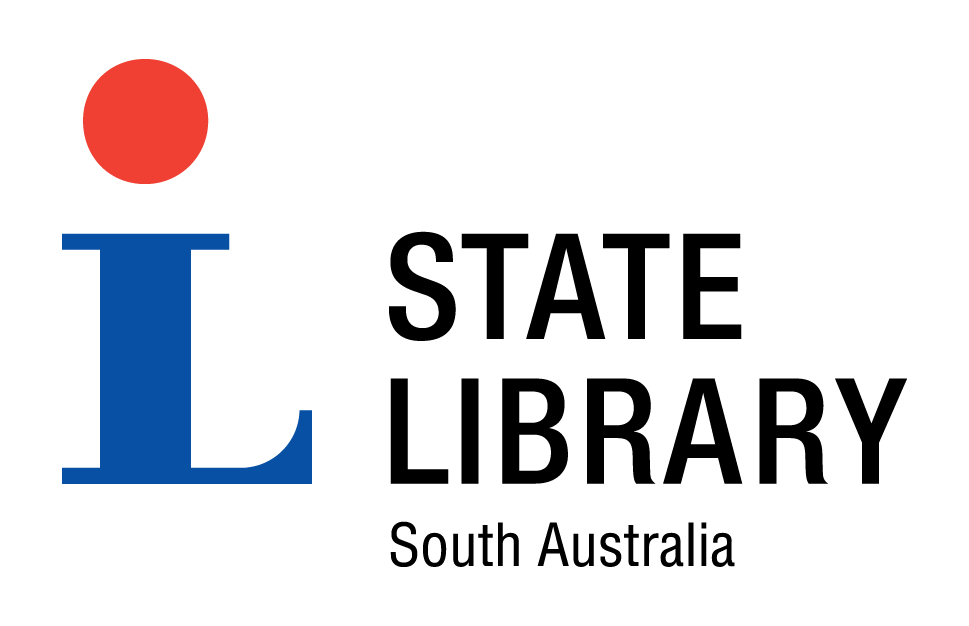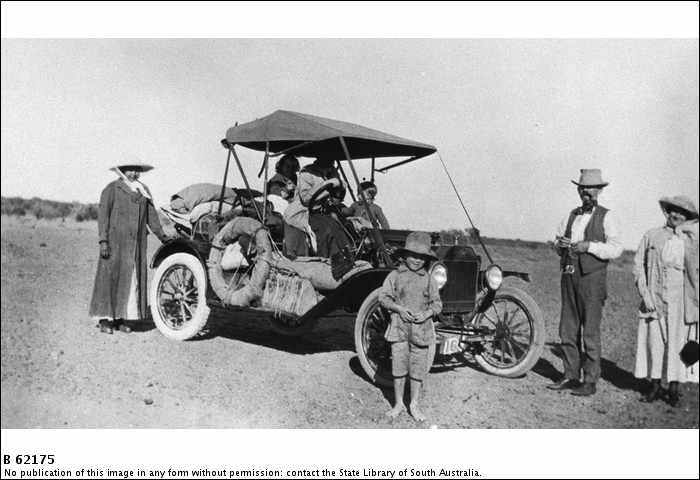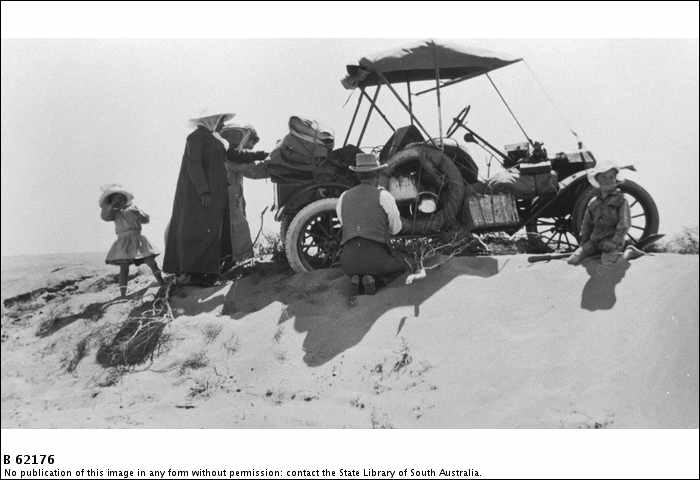Suggest a topic
Suggest a new Did you know? topic

Epic car journeys
891 ABC Afternoon Delights at the State Library : 30 August 2005
Carole Whitelock talked with Michael Talbot
|
B 62175 - Gaffney family at Eight Mile Creek, 1916 |
B 62176 - Gaffney family bogged near New Well, 1916 |
We've all undertaken a trip by car that has assumed epic proportions - either by planning or accident.
Several people come to mind as early epic Australian motoring adventurers. HH Dutton and Murray Aunger made the first journey from Adelaide to Darwin in 1908. Francis Birtles, also known for his cycling exploits, made the first west to east crossing in 1912 and by mid-1927 had made more than 70 transcontinental crossings.
These were people who set out to break records or seek adventure. For others, such as Joseph Kelly's drive to Birdsville, it might come as part of his job.
Dutton and Aunger 1907-08
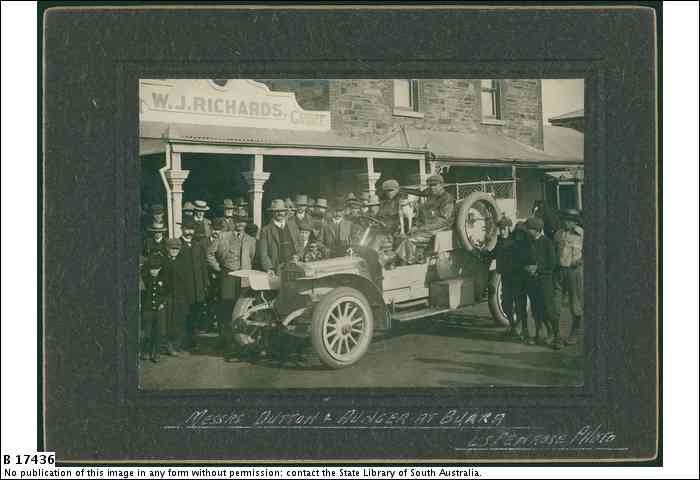 |
|
|
B 17436 - Dutton and Aunger at Burra, 1908 |
HH Dutton was a wealthy landowner near Kapunda. With Murray Aunger a talented mechanic and motoring enthusiast, he decided to demonstrate the practicality of the motor car for outback travel by driving from Adelaide to Darwin. He bought a 3.7 litre, 20 HP Talbot which he christened Angelina. He and Aunger left Adelaide from King William Street, near the General Post Office, on 25 November 1907. The Observer reported that 'Mr Dutton took the seat at the steering pillar, and when the clock boomed out the noonday hour the car was set in motion to the accompaniment of hearty cheers from those present.'
By Christmas they were near Barrow creek on the way to Tennant Creek with about three quarters of the journey completed. But the wet season had begun, and in attempting to free their bogged car, a pinion in the back axle broke. The spare had been used earlier, and without a replacement they had to abandon the journey. They covered the car, making it as weatherproof as possible and set out for Oodnadatta on foot. Joining up with a camel train, they returned to Oodnadatta where they caught the train back to Adelaide.
In 1908 Dutton bought another Talbot - nicknamed 474 after its registration number. With the experienced gained in 1907 he specified a more powerful engine, and a lower axle ratio. The expedition left earlier - on 30 June 1908 - to avoid the wet season.
Some days they were able to travel more than 100 kilometres, but on others the harsh conditions limited them to as few as 16 kilometres. During the journey they experienced gibbers, rocky gorges, rivers, sandhills and bushfire. Mechanical problems were limited to punctures and broken leaf springs, and the tyre firm, Michelin, advertised that the journey had been accomplished on only one set of tyres.
Finally, on the afternoon of 20 August 1908, they drove into Darwin after 51 days on the road.
Francis Birtles
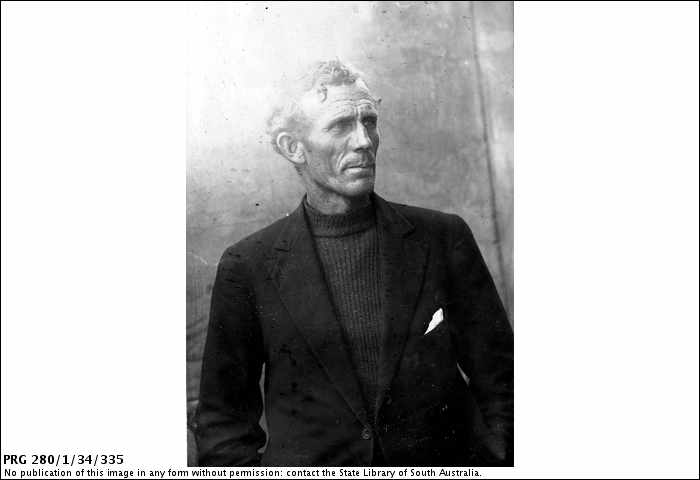 |
|
|
PRG 280/1/34/335 - Francis Birtles, 1923 |
Francis Birtles served in the Boer War, and for a time was a mounted police officer in the Transvaal. These experiences taught him bushcraft skills which he put to use when he returned to Australia and began making transcontinental journeys. As a cyclist, Birtles had cycled round Australia twice and crossed the continent seven times by 1912 when he took to car travel. In 1912 he became the first person to make a west/east crossing from Fremantle to Sydney by car.
Describing his Brush car, Birtles said:
I had a car. As cars went in those days, it was a good car. It had one cylinder and developed ten horse-power. There was a chain drive to the two rear wheels. It had wooden axles, and the two-seater body was supported on spiral springs. In these days, a man accustomed to the modern car would scarcely trust such a one as ours to take him on an errand from one suburb to another. We expected it to take us, from one ocean to another.
Birtles became an inveterate outback motorist, who completed more than 70 transcontinental crossings by mid 1927. Some of his journeys are detailed in Battle fronts of outback which he published in 1935.
Battle fronts of outback
Birtles' account of his exploits illustrate the problems that faced early motorists. One was the need to carry plenty of fuel and water. At the start of one journey he had six cases of petrol and oil and forty gallons of water. Unforeseen conditions could make even these quantities insufficient.
On one occasion, driving from Birdsville to the Gulf of Carpentaria, he ran into difficult conditions that necessitated slow travelling in low gear for an extended period. He ran short of water. Travel by car was too slow to make the nearest water in the Georgina river, even after dumping most of his equipment. Finally, after walking without water for more than a day, Birtles and his dog found a pool near the river. 'It took me a long while, sipping with caution, to allay my thirst'.
Still on foot, Birtles found Glen Gyle station where he 'was taken in and, during the several days that it took me to recover, was treated with true outback kindness'.
When he returned to his car he found that the difficult conditions had run him short of fuel as well. Returning to Glen Gyle station he 'learned that a hundred and twenty miles away a spirit-driven engine was being used.'
|
This was the nearest point at which I might I obtain benzine. Refusing a kindly offer of a loan of horses, I set out on my bicycle. After travelling about twenty-five miles I fell in, and had my midday meal, with a cattle-drover. He told me that a car had arrived at Cluny station, on King's Creek. At about four in the afternoon, after abandoning my bike and swimming the wide and weedy stream, I found the car. It was standing in the shade of a tree. I reached the homestead, and there met Mrs Duncan, the owner-driver, who had made a pioneer journey with her brother across six hundred miles of central and western Queensland. They were stranded, also, for lack of petrol, and had not sufficient to carry them to their station, some hundreds of miles farther on. She and her brother had just arrived at Cluny. The manager of Cluny came to our rescue. He undertook to send a buggy to Boulia -- three days distant -- to get the necessary spirit. |
Australia is a land of contrasts. The driver who brought the petrol supplies also brought news that the river was coming down in flood and Birtles would have to be quick to get away before the river was impassable.
Bush mechanics
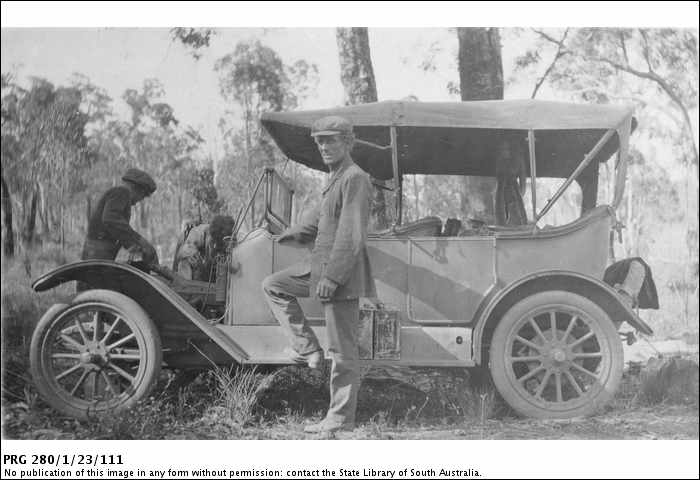 |
|
|
PRG 280/1/23/111 - Working on the engine of a broken down car, 1921 |
On another trip, Birtles had been working on his car's engine in appalling sandstorm conditions. Reassembling the engine he had to use his last spare head gasket. At sunrise I cranked up once more - and heard a swish of water sounding in the sump. The gasket had blown again!' Two spare gaskets were following by post but they did not catch up with him for months. Using shellac to repair the damaged gasket didn't work. A gasket cut from the heavy sailcloth hood blew out before he had gone a hundred yards. He tried again, cutting up a leather suitcase, but there was another blowout before he had gone a quarter of a mile.
Eventually I cut up a fibrolite suit-case to get another gasket. I soaked it in hot oil, and I smeared a tin of apple jelly over the head and block in the hope of making all secure. After screwing the head back into place I put the last of the water into the radiator - keeping back only sufficient for a quart-pot of tea.
This makeshift repair lasted for several thousand miles of careful driving. But, trying to escape a bushfire, the car had to be driven harder and 'there was a spurt of water from the radiator cap and a horrible rattle from, the engine'. A piston had been smashed, the connecting rod bent and the gudgeon pin scored the cylinder walls.
Although he had spares, the wet season was coming, and without a new gasket Birtles doubted repairs would be effective. Leaving the car on high ground a group of aboriginals helped him move his gear to a cave in some hilly country where he camped for three months. His mail - including the two spare gaskets - arrived at the end of the wet season.
'I went back to the car and overhauled it. The magneto was shorted, the battery was flat, everything rusty, and grass ten feet high covered all. It took me a couple of weeks to get it in going order. I lived on young sand palm tops and black bream from the creek.'
The purpose of this trip was to explore for gold, but Birtles was not successful and he decided to head back to Melbourne, travelling on three cylinders.
There was no compression in number one, water and grit having cut out the white-metal connecting-rod bearings. It took me six months to travel two thousand miles, then one day, while going down a steep grade in desert country, the gasket blew again. Water jammed on the compression stroke and a big piece blew out of the wall of number three cylinder.
In a howling sand-storm I walked to the railway. I camped there and, after a few weeks of waiting, managed to get an old model T Ford engine. I bolted this to the chassis and threw the other engine away. This carried me back to Melbourne.
All in a day's work
In 1916 Joseph Kelly was a demonstrator with Duncan and Fraser - 'Carriage Builders, Motor Car Importers and Manufacturers, 46 Franklin Street' in Adelaide. If a buyer couldn't drive, Joseph would drive the person home in their new car and stay with them for a few days to teach them to drive.
One day Jack Gaffney, the proprietor of the Birdsville pub came in. He was on holiday with his wife and family. The Diamantina had come down in flood, and to get home they'd have had to take pack horses for the last ninety miles into Birdsville. Rather than do that, Jack Gaffney bought a car and said to Joseph Kelly 'You'd better take me back to Birdsville.'
The party consisted of Kelly as driver, Mr and Mrs Gaffney, their two children, a nursemaid and a housemaid - seven people plus luggage on a T model Ford.
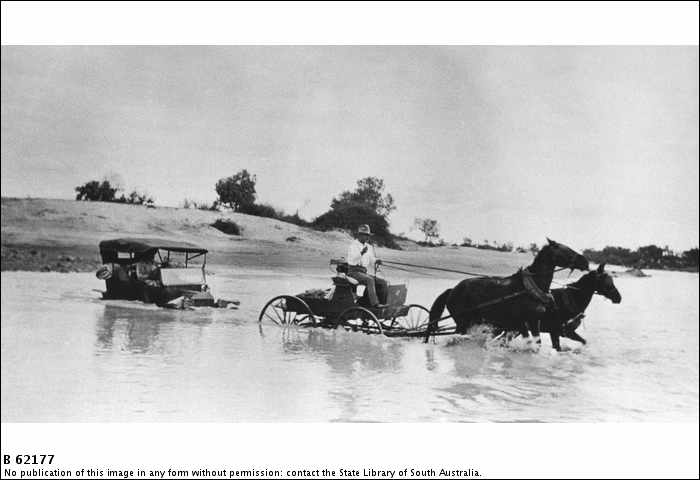 |
|
|
B 62177 - Car being towed through the Diamantina River, 1916 |
Photos show them dealing with sand hills, and being towed across the Diamantina by a horse and buggy. But it was a trouble free trip - a single puncture being the only mechanical problem. Kelly had to spend a week 'cooped up' in Birdsville, giving driving lessons to various people and overhauling the car. Then he started home by packhorse with the mailman, finally completing the journey from Oodnadatta by train.
Although he said it was a great experience, Joseph Kelly 'never took much notice of it at the time'.
'When I came back Duncan's wanted to know about it and I saw their head salesman and just told him the outline of it. They never made much of it and it wasn't till later years that the RAA got hold of the story ... I never thought much about it. It was all in a day's work. But I was jolly glad to get back because I don't know how I'd have managed if anything had gone wrong.'
References
General accounts
The story of Australian motoring : the complete history of motoring, from the first horseless carriages to our cars of today / by Keith Winser. [Melbourne] : Motor Manual, [1956].
The wild roads : the story of transcontinental motoring / [by] T. R. Nicholson. London : Jarrolds Publishers, 1969.
An Illustrated treasury of Australian epic journeys / selected by Anthony Barker. South Melbourne : Macmillan Australia, 1990.
Great motoring stories of Australia and New Zealand / presented by Jack Pollard. Adelaide : Rigby, [1978].
Dutton and Aunger 1908
Across Australia by motor / [photographed by H. H. Dutton], Adelaide? : H.H. Dutton, [1909] (Adelaide : J.L. Bonython).
Birtles
3,500 miles across Australia in a Ford car : from the Gulf of Carpentaria to Port Phillip Bay / by Francis Birtles ; edited and compiled by G.W. Whatmore. Adelaide : Duncan & Fraser Ltd., [1914?].
Battle fronts of outback / by Francis Birtles. Sydney : Angus and Robertson, 1935.
Darwin to Adelaide, 9 days, 9 hours, 15 minutes : Francis Birtles' history making journey, 18th-27th Nov. 1924. Melbourne : British Imperial Oil Co. Ltd., [1924?].
Kelly
'Joe, 92, remembers drive to Birdsville', Advertiser, 1 September 1983, p. 2.
Kelly, Joseph Arnold. Interview with Joseph Arnold Kelly [sound recording], OH 1/15.
Bullock tracks and bitumen : South Australia's motoring heritage / [by] Stuart Nicol. Adelaide : Royal Automobile Association of South Australia, 1978.
More Afternoon Delights
ABC Afternoon Delights at the State Library was a series in which Carole Whitelock talked with Michael Talbot from the State Library about South Australian topics, illustrated by items from the Library's collections. View the associated SA Memory page for each topic.
